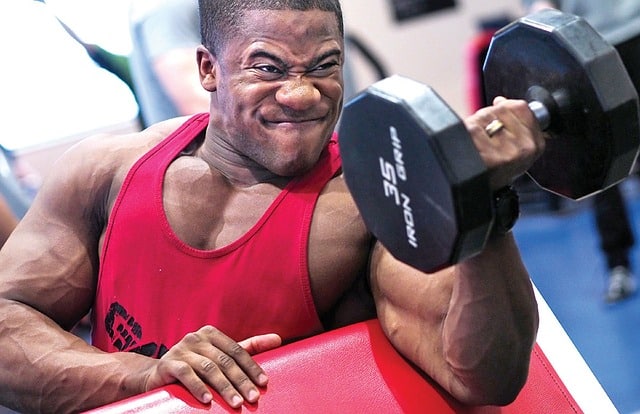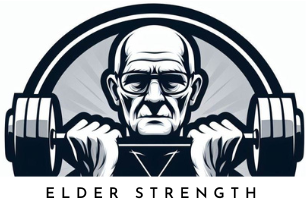The favorite muscle group of wannabe bodybuilders and gym rats all around the world, the biceps are not the most important muscle of the body, but they do have their function.
Most people have enough bicep strength for day to day actions but seniors can develop weakness that affects daily activities in the biceps due to inactivity and age-related muscle atrophy.
Biceps and responsible for flexing and rotating your elbow joint as well as stabilizing the motion of your arms and hands, especially when carrying anything of significant weight with flexed elbows (like a lunch tray).
Seniors with very weak arms and upper body strength can have difficulties with coordination and dexterity of the hands and the arms simply because of weakness of the muscles.
Biceps are one of the largest muscle groups in the arms along with the triceps and the muscles of the forearms, so training them is definitely a good idea. Like training all your other muscle groups is.
The problem with bicep curls is that they aren’t very useful for other purposes than bodybuilding. Sure, they will get your biceps stronger but if you have followed me for a while, you will know that I appreciate functional strength and thus functional exercises above anything else.
Bicep curls simply are an exercise that you really don’t perform in real life and your biceps virtually always work in tandem with your upper back muscles.
Thus pulling upper body exercises like the lat-pulldown or the seated cable row will activate both your upper back AND your biceps. They are not optimal for bicep development in bodybuilding, but they are more than enough for improving bicep strength for overall health and functionality purposes.
But if you still want to do bicep curls because you like them and want bigger biceps (I’m looking at you gentlemen!), I’m going to show you how.
What is a bicep curl
The bicep curl is a strength training exercise that involves flexion of the elbow joint. The bicep curl can be performed with several different resistance devices and variations.
While the exercises differ to an extent the common thing is the “curling” motion, which involves bringing the forearm from full elbow extension (straight arm) to full flexion.
Some variations will finish with a slight shoulder flexion because the other end of the bicep muscle connects to the shoulder joint.
This activates the biceps muscles of the upper arm as they are the muscles responsible for elbow flexion. Bicep curls are one of the most iconic bodybuilding or weight training exercises and something that regular people instantly think about when talking about lifting weights, just like the bench press.
Ironically the bicep curl is not a very useful exercise if you are training for health and performance, due to the limited real-world use for the motion and bicep strength.
The reason why bicep curls are so popular is the fact that muscular arms have always been regarded as a sign of strength and vitality, especially in men. Big biceps on men are generally thought of as “good looking” or “sexy”.

There are tons of young and old guys that have a “beach body”, which means trained pecs, triceps, biceps and abs combined with relatively low body fat. They will usually have zero leg, back and trap development and no real functional strength.
Even though muscular arms can be a sign of strength and vitality, large biceps definitely don’t tell anything about persons’ actual functional strength or health. You can have large biceps and be weak and unhealthy.
From this rant, you can probably figure out that I don’t really see bicep curls as a necessary exercise for seniors. I don’t also encourage doing strength training simply for looks, even though improved posture and appearance is a nice plus.
Muscles involved in the bicep curl
The main muscle involved in the bicep curl is the bicep brachii, a two-headed muscle situated at the top of your upper arm. I’m sure you have flexed your bicep sometime or seen someone else do it.
The bicep muscles work across the elbow and the shoulder joint. Its main functions are flexing the elbow joint and supinating (rotating counter-clockwise form your own observation point) the forearm.
The long head of the biceps that connects to the shoulder joint prevents the upward displacement of the head of the humerus and assists in forward flexion of the shoulder joint (bringing the arm forward an up).
When using significant weight, especially in a standing position), the bicep curls will also activate your core, and upper back musculature as stabilizers.
Variations of the bicep curl
The bicep curl can be done in several variations and with different types of weights. You can do bicep curls with at least dumbbells, barbells, cable machines and “EZ-bars”.
The grip on a bar can be either underhand or overhand, underhand being by far the most common. The underhand grip targets Using the overhand grip, you will
Dumbbells allow one or twohanded versions of the movement, as well as the rotation of the forearm. As one of the main functions of the bicep muscle is to supinate the forearm, adding a slight supinating rotation to a dumbbell curl can make it more effective.
Cable machines can be used with different types of handles that allow either two or one hand curls with different angles. There are curved bars, single-arm handles and straight bars that all target the muscle a bit differently but the actual differences are quite small.
The EZ-bar is a special small barbell that’s specifically designed for bicep curls and tricep pullovers. It has a bent bar shape that allows a slightly supinated position of the forearms. This makes the movement easier on the elbows and slightly more effective for the biceps.
How to perform the bicep curl
No matter which variation of the bicep curl you are performing, it will follow these main principles:
- The movement starts with the elbow fully extended and the weight in your hand.
- The weight is lifted by flexing the elbow usually as far as possible
- The weight is lowered either to full elbow extension, or slight flexion to maintain tension in the muscle before the next repetition.
Conclusion
Even though I really don’t recommend bicep curls for seniors, I hope you found this information useful if you decide to include them in your exercise routine.
My recommendation is to do a balanced compound movement routine instead of isolation exercises like the bicep curls. They get you better results in a time-efficient manner because you train several muscle groups at once.
The additional benefit of compound movements is that strength built with them is generally very transferrable to the real world. Meaning the exercises are very beneficial for your actual strength and performance doing stuff outside the gym.
Activities like walking, running, kayaking, golf, and cycling will become much easier when you have good full-body strength and mobility. And don’t think for a second that you are too old to improve these attributes. Everyone can improve their strength, no matter what their age.
So a routine consisting for example of squats, deadlifts, push-ups, and lat pulldowns would be perfect for seniors and would even make your bicep strong (probably more efficiently than doing bicep curls). If you are interested in such a program, you are in luck! You can download my free strength training program here.
If you enjoyed reading this article, please consider subscribing to my newsletter and bookmarking this site. Social shares are also appreciated!
See you next time.


I like your honesty here in regards to the bicep curl. I do appreciate that you went on to describe how to do it correctly and providing the different variations.
Of course there will still be many who wants to do this exercise as they have their own reasons why they think it will benefit them. At least now they are more educated and also know exactly how to do it.
Thanks for the comment Nate! People definitely have their reasons for doing bicep curls and I actually think it’s a fine movement if you want big biceps. Hell, I do them sometimes myself as an accessory exercise to compound exercises. But I don’t like the way the bicep curl and bench press have been made a poster child of the whole gym and strength training world when they are actually couple of the less useful exercises for overall strength development. Especially if you are simply trying to improve your health and have a more functional body they are just inefficient for achieving that goal. Spend the same time doing something that builds your back and posterior chain and you will have much better carry over to the real world. Ok, the bench press is a very effective upper body strength builder IF you perform them correctly and build some serious strength with them.
It is great to see some content in relation to keeping fit for those of us above a certain age.
The information is very informative and well worth a read.
It would be really good if you could add some images of seniors highlighting just how important it is to remain strong in order to maintain a healthy life, even in the senior years.
Great website though.
Sandra
Glad you liked it Sandra! The older you get the more important strength training becomes for your health. There seems to be this misconception in our society that old people shouldn’t lift weights because they will hurt themselves or something. When actually lifting weights is one of the best ways to prevent injuries and many ailments that are caused by aging. I plan on adding a lot of pictures in the future, I just have to figure out if I’ll use a stock photo service or produce my own pictures (would prefer this). But it’s on the todo-list 🙂